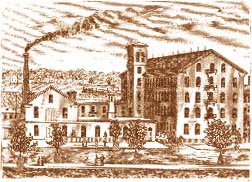 The Merrick Thread Company.Dates its origin from July, 1865. It was the outgrowth of a partnership with Timothy Merrick, Austin Merrick, and Origen Hall as partners, under the firm name of Merrick, Bro. & Co., located at Mansfield, Conn., and engaged in the business of spooling three cord cotton thread. The business of the firm grew so rapidly that in 1864 it became necessary for them to seek for some other location affording the requisite facilities, especially in the matter of water-power, to enable them to enlarge their business and make provision for manufacturing the better quality of six-cord thread that the use of the sewing-machine demanded. A careful examination of various localities resulted in the selection of Holyoke as the future home of their business, and on the 27th day of July, A.D., 1865, the first meeting was held for organization as a corporation under the laws of Massachusetts. The organization was effected with Elisha Johnson, of Wethersfield, Con., as president, and Timothy Merrick, of Holyoke as treasurer and clerk, and the following as board of directors, viz., Elisha Johnson, Timothy Merrick, Herbert F. Palmer, Austin Merrick, Origen Hall, George Chapman, Lyman R. Hopkins, Palmer Southworth, William Boardman, adopting as their corporate name The Holyoke Thread Company, which was at a subsequent meeting changed to The Merrick Thread Company, with a capital of $200,000. The business of the corporation, as set forth in the articles of association, is the manufacture of spool cotton. The company, having leased the necessary mill-site and tenement grounds from the Holyoke water-Power Company, along with three mill-powers of water from the second-level canal, began at once the foundation for the necessary buildings, and the following year completed the structures substantially as they appear today. The dimension of the principal buildings are as follows: main building, 206 by 66 feet, four stories high, besides attic; picker-houe and repair-shop, 114 by 40 feet, two stories; all forming three sides of a square, which is completed by the office building and gangway, affording communication between the various parts through the interior court. One-half of the capacity of the buildings having been taken by the necessary carding, spinning, and twisting machinery, the company near the close of 1867 commenced the manufacture of three-cord spool cotton, giving employment to about 200 hands. Jan. 1, 1868, the capital stock was increased to $350,000, and the filling of the balance of the unoccupied room with the necessary carding, combing and spinning machines requisite to the most approved methods of working fine Sea Island cotton soon followed, enabling the company to produce a first-class article of six- and three-cord spool cotton, especially adapted to meet the requirement of manufacturers of clothing, straw-goods, and soft leather, as a substitute for silk or linen, besides being suited for use in the shuttle of the sewing-machine, thus avoiding the necessity of filling the iron bobbin i the usual way, has grown to be quite an important branch of the business, which the company control under a license from the patentee. Some two years since a further addition to the plant became necessary, and the company acquired by purchase from the assignees of the Hampden Mills the property known as "Little Hampden," putting the mill in complete repair and filling it with the most improved machinery for making the coarser numbers of their three-cord thread, which do not require Sea-Island cotton. The present capacity of the works is as follows: fine mill, 11,544 spindles spinning, 6300 spindles twisting; coarse mill, 4048 spindles spinning, 1656 spindles twisting. Add to the foregoing the entire machinery for the manufacture of the spools and the dyeing, bleaching, dressing, and spooling of the entire product of the spindles of the plant, and there is a yearly product amounting in value to $450,000. The manufacturing department is under the efficient supervision of J.M. Dunham, Esq., who has ably filled the position of superintendent for the past ten years. The present officers of the company are as follows: President, Lyman R. Hopkins; Treasurer, Timothy Merrick; Clerk and Paymaster, C.W. Reder; Board of Directors, Timothy Merrick, Lyman R. Hopkins, Herbert F. Palmer, C.W. Reder, George C. Basson, John Amidon, S.W. Robbins. Principal selling office, 370 Broadway, New York; 276 Devonshire Street, Boston; 248 Chestnut Street, Philadelphia; 27 German Street, Baltimore.
| HolyokeMass.com Blog
| HolyokeMass History | Hampden County |
| Western Mass History & Genealogy |
© Laurel O'Donnell 1997 - 2012, all rights reserved
This is an adaptation of the original publication This document may be downloaded for personal non-commercial use only and cannot be reproduced or distributed without permission. |